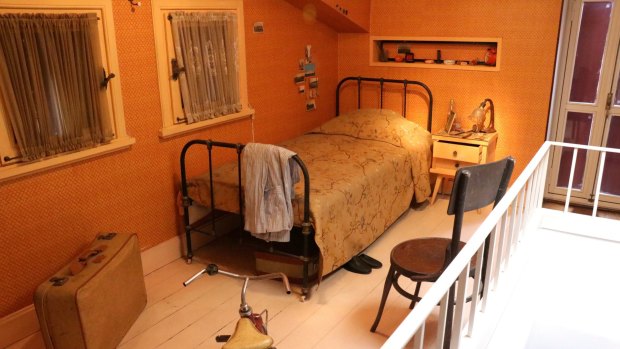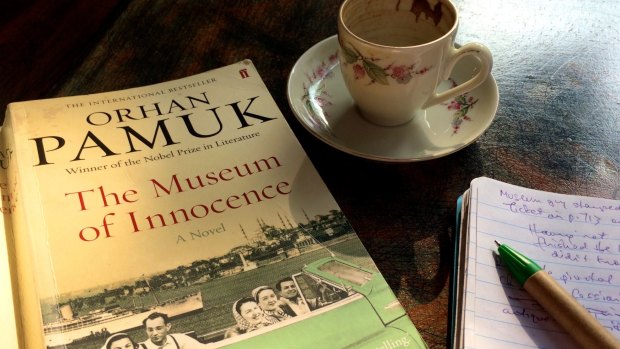This was published 4 years ago
Istanbul's Museum of Innocence follows an ill-fated love story
By Louise Southerden

Kemal Basmaci's attic bedroom.Credit: Louise Southerden
You've read the book? Now see the movie. Or, if the book happens to be Orhan Pamuk's The Museum of Innocence and you're in Istanbul, try this: see the museum.
When it opened in 2012, four years after the best-selling novel was published, the Museum of Innocence was the first in the world to be dedicated to a work of fiction. But it wasn't created to capitalise on the book's success. Pamuk actually had the idea for the museum first and collected objects for it even before he started writing.
On my first day in Istanbul, I find a paperback copy of The Museum of Innocence at the open-air book bazaar. It soon becomes my accidental guide to Turkey's largest city, offering a view of contemporary Istanbul through the lens of how it used to be, in the 1970s when the novel begins.

Reading Orhan Pamuk over a Turkish coffee after visiting the museum.Credit: Louise Southerden
It's a bit of a tragic story. Thirty-something Kemal is engaged to the beautiful Sibel when he begins an affair and falls for 18-year-old Fusun. What follows is 700-odd pages of love, loss, depression and obsession as – spoiler alert – Kemal loses both women and spends eight long years pining for Fusun, collecting objects she has touched, worn or used to soothe his breaking heart.
In a tangled swirl of art imitating life and vice versa, Kemal eventually buys the 19th century timber townhouse where Fusun had lived with her family from 1974 to 1999 (Pamuk bought the building in 1999) to turn it into a museum for his collection and, in the book, enlists Pamuk to write his story.
I'm halfway through it when, back in Istanbul after spending a week travelling around Turkey, I finally get to the museum. It's close to Taksim Square, on the city's popular European side, but deep in the maze of crooked streets that make up the residential Cukurcuma district, a world away from the snaking lines of tourists I'd seen outside Hagia Sophia.
Entering the museum is like being admitted to a private club, particularly if you bring a copy of the book as it contains a "ticket" that museum staff will stamp, giving you free admission. I step into a gallery-like space with white walls and an open staircase linking the four floors of the building Pamuk spent 13 years transforming into this small but innovative museum.; printed on page 713 is a ticket
It won European Museum of the Year award in 2014, in fact, for its "personal, local and sustainable model for new museum development" and "its radical exploration of the psychological meaning of the collecting process," as it says on a plaque near the entrance.
There's a glass-fronted display case for every one of the book's 83 chapters, each a work of art in its own right. The chapter one exhibit, for instance, is a billowing curtain that moves as if in a breeze, despite being inside a small box mounted on the wall like a painting.
Other exhibits contain ordinary objects such as glasses of Turkish tea, a handful of Istanbul soil, photographs of society events, matchbooks from bars that were hip in the '70s – all chosen and arranged to create a particular mood or illustrate a scene from the novel. Often the objects would "talk among themselves", says Pamuk on the audio guide, the design process guided by intuition and "the serendipitous nature of beauty".
Some of the cabinets have secret, unmarked wooden drawers underneath, where people have surreptitiously left their own objects, mostly ticket stubs, coins, photos and comments about the museum scribbled on scraps of paper like an unofficial visitors book.
It's delightful and poignant, joyful and sad. There's an almost holy vibe about the place; visitors are asked to switch their phones to silent and keep their voices low. The weekday morning I'm there the only sound is the creaking of wooden floorboards and the stairs as everyone moves around. The rooms are dimly lit and the windows shuttered, adding a cinematic quality, although sunshine beams down the central stairwell from a skylight in the attic.
You don't have to have read the book – Pamuk intended the novel and the museum to be experienced independently – but the audio guide is a must, fleshing out the story with sound effects, insights into the museum's design and passages from the book read by an actor.
Climbing the last flight of stairs – past spoons, corkscrews and clocks suspended in the Perspex railings – I reach the attic where Kemal lived for five years "until he passed away on 12 April 2007". Pamuk's handwritten manuscripts are displayed there too, alongside his detailed drawings for the exhibits (he painted and studied architecture before becoming a writer).
Back on the ground floor, I stand before the museum's most impressive exhibit: 4213 lipstick-stained butts of cigarettes smoked by Fusun and painstakingly pinned like beetles to an entire wall of floral wallpaper, a note about its origins under each one in Kemal's handwriting – or Pamuk's.
It's all so convincing, I can't help asking a museum attendant: was Kemal a real person? "No," he says, in a way that makes me feel it's not a stupid question. "He is fiction."
In the basement gift shop, which is lovelier than it sounds thanks to high ceilings and another skylight, copies of Pamuk's novels are available in various languages along with books about museum design, replicas of Fusun's butterfly earrings (which feature in the novel) even, in a curious circularity, a book about the museum: The Innocence of Objects, also by Pamuk.
When I finally emerge to the quiet street outside, I feel slightly disoriented, as if I'd just seen an intense movie and am somehow still in it. Cukurcuma's cobbled lanes flanked by antique shops perpetuate the feeling, their dusty wares – baskets of old photographs, antique antlers, vintage Turkish coffee sets – spilling onto the footpaths.
Eventually I collapse onto a velvet-cushioned chair in the sun outside Cukurcuma Antiques Cafe and order a Turkish coffee, hoping this will return me to my senses. And it does, temporarily. Still, the Museum of Innocence clings to me like Fusun's cigarette smoke for the next day and a half, adding something to my sightseeing that's hard to describe.
During a Bosphorus cruise, for instance, I see "yali" holiday houses lining the shore, remembering that's where Kemal and Sibel used to spend their summers. I visit the waterfront Dolmabahce Palace, a sort of mini-Versailles that symbolises the allure of Western European culture for Istanbul's elite.
On my last day in Istanbul, I catch a ferry to Uskudar on the city's Asian side and see a man swimming backstroke in the Bosphorus. I'd read of Kemal doing this, in chapter 41, and thought it far-fetched: who would swim in a busy shipping channel? But this man is doing just that, bobbing amid fishing boats, car ferries, pleasure craft and cargo ships bound for the Black Sea. I stifle an impulse to call out to him, as Sibel had in the book, "Be careful!"
Suddenly, regretting not bringing my own swimsuit and the Turkish towel I'd bought at the Egyptian market, I slip off my shoes and socks, perch on the rocks at the water's edge and let cool waves surge over my feet. It's refreshing and real and totally unexpected, to be sitting barefoot by the Bosphorus looking up at the Blue Mosque's minarets dominating Istanbul's skyline. And I have a book to thank for it – and the exquisite little museum that had brought it, and this intriguing city, to life.
FIVE MORE WAYS TO EXPERIENCE PAMUK'S ISTANBUL
SEE THE BOSPHORUS
Catch a ferry to Istanbul's Asian side, tossing pretzel-like simit to seagulls, snatch glimpses of this strait at the end of steep narrow streets on the European side, or gaze down on it from a rooftop cafe near Suleymaniye Mosque.
READ WHILE SIPPING TURKISH COFFEE
Pamuk's seven novels set in Istanbul, including The Black Book and My Name is Red, offer a local's perspective. Try Cukurcuma Antiques Cafe near the Museum of Innocence. See cukurcumaantiquescafe.com
CROSS GALATA BRIDGE
The T1 tram line glides back and forth between Europe and Asia but to get a real sense of Istanbul life, walk across the Galata Bridge, past fishermen standing rod-to-rod against the railing.
SIT IN GULHANE PARK
Outside the high stone walls of the Topkapi Palace, in the old city, this park is a haven of calm, its tall plane trees provide shade on steamy summer days. In winter, stalls sell roasted chestnuts.
STAND IN TAKSIM SQUARE
The centre of modern Istanbul, hub of its Metro and site of the Independence Monument to Ataturk, Taksim is an ideal place to ponder how much Istanbul has changed since Pamuk's childhood, which he writes about in his memoir Istanbul: Memories and the City.
THE DETAILS
Louise Southerden was a guest of Intrepid Travel.
MORE
FLY
Turkish Airlines, codesharing with Qantas, flies daily from Sydney, Melbourne and Brisbane to Istanbul via Singapore. See turkishairlines.com
VISIT
The Museum of Innocence is open every day except Monday from 10am to 6pm (9pm on Thursday). Entry is 40 Turkish lira or free if you bring a copy of the book, even on an e-reader. See en.masumiyetmuzesi.org
STAY
Gezi Hotel Bosphorus, a member of Design Hotels Group, is a short walk from the museum and has rooms with Bosphorus views from 130 euros a night. See gezibosphorus.com
Sign up for the Traveller Deals newsletter
Get exclusive travel deals delivered straight to your inbox. Sign up now.